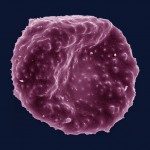Lien vers Pubmed [PMID] – 29258508
Malar. J. 2017 Dec;16(1):493
BACKGROUND: Plasmodium falciparum malaria is one of the most widespread parasitic infections in humans and remains a leading global health concern. Malaria elimination efforts are threatened by the emergence and spread of resistance to artemisinin-based combination therapy, the first-line treatment of malaria. Promising molecular markers and pathways associated with artemisinin drug resistance have been identified, but the underlying molecular mechanisms of resistance remains unknown. The genomic data from early period of emergence of artemisinin resistance (2008-2011) was evaluated, with aim to define k13 associated genetic background in Cambodia, the country identified as epicentre of anti-malarial drug resistance, through characterization of 167 parasite isolates using a panel of 21,257 SNPs.
RESULTS: Eight subpopulations were identified suggesting a process of acquisition of artemisinin resistance consistent with an emergence-selection-diffusion model, supported by the shifting balance theory. Identification of population specific mutations facilitated the characterization of a core set of 57 background genes associated with artemisinin resistance and associated pathways. The analysis indicates that the background of artemisinin resistance was not acquired after drug pressure, rather is the result of fixation followed by selection on the daughter subpopulations derived from the ancestral population.
CONCLUSIONS: Functional analysis of artemisinin resistance subpopulations illustrates the strong interplay between ubiquitination and cell division or differentiation in artemisinin resistant parasites. The relationship of these pathways with the P. falciparum resistant subpopulation and presence of drug resistance markers in addition to k13, highlights the major role of admixed parasite population in the diffusion of artemisinin resistant background. The diffusion of resistant genes in the Cambodian admixed population after selection resulted from mating of gametocytes of sensitive and resistant parasite populations.

